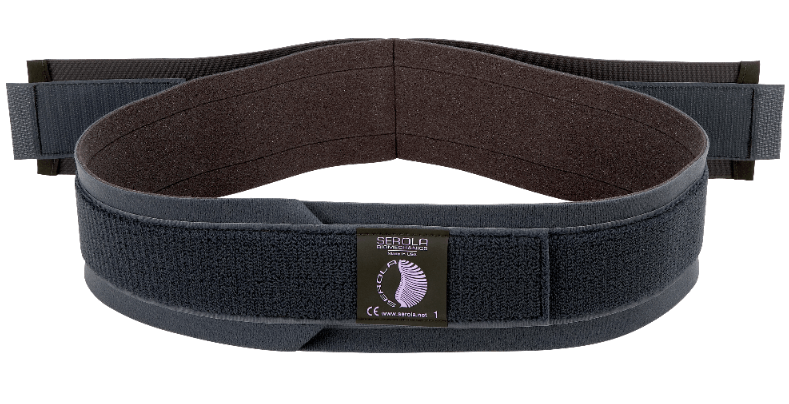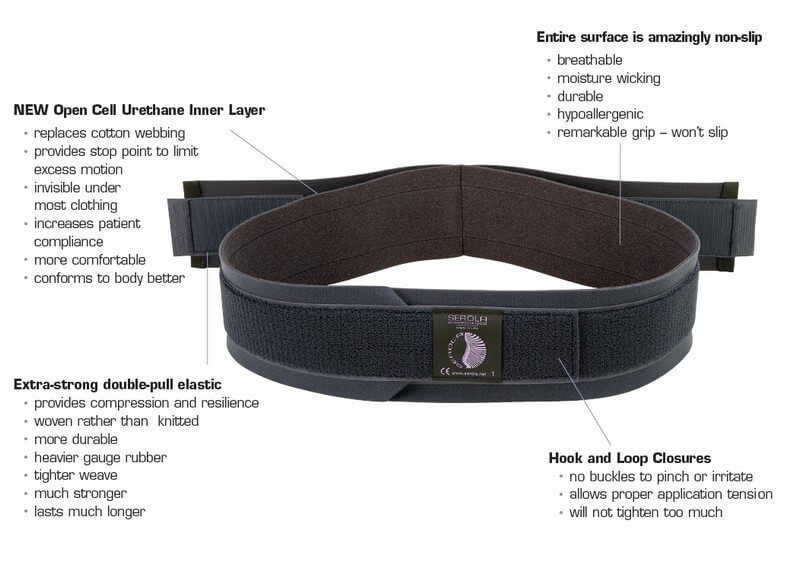Serola Sacroiliac Belt

In 1988, Dr. Serola discovered that strength increased after sacroiliac stabilization. After years of research, he developed a theory based on biomechanics (see www.serola.net). He thought that a properly made belt could stabilize the sacroiliac joint, and help the muscles become stronger, more relaxed and less painful. Not finding one on the market, he developed his own belt based on his discovery. Now, the Serola Sacroiliac Belt is being used to provide pain relief, and help prevent injury, to thousands of new people every month throughout the world.
Common Problem
CAUSE: With the emergence of the science of biomechanics, the sacroiliac joint has been shown to be the major biomechanical cause of low back pain.
EFFECT: Sprained ligaments in the sacroiliac region cause imbalanced muscular responses which lead to structural compensation patterns, muscle spasm, weakness, and back, hip, and leg pain.
How it Works
Because of the stability provided to the base of your spine by The Serola Sacroiliac Belt, strength is increased throughout your back, hips, and legs. Therefore, chances of injury are lessened considerably during work or play.
The Serola Difference
-The Serola Sacroiliac Belt’s patented design makes it the only belt that effectively normalizes the function of the sacroiliac joint.
-Non-elastic layer mimics action of ligaments and provides a stop point at the end of normal range of motion.
-Elastic layer provides compression to help pull the SIJ together and maintain correct posture.
-No irritating buckles or pads
-Takes place of the ligaments, not the muscles, therefore improving muscle function and strength throughout the body
-Can be worn for extended periods without causing muscle weakness or atrophy

In choosing the correct belt, we must consider the function of the ligaments:
-Ligaments Establish a Stop Point at the end of range of motion (r.o.m.)
-Ligaments Are Essentially Non-Elastic – elastic cannot establish a stop point
-Ligaments Do Not Compress a Joint – they allow movement within normal r.o.m.
-Ligaments relay position sense to help regulate muscle tone (ligamento-muscular reflex)
Biomechanical Studies have found that correct tension for a sacroiliac belt is about what you would use to tie a shoe. Within the SI Joint, the only means of fluid exchange for inflow of nutrients and outflow of metabolic wastes is pressure variance. Cinch the belt too tight (with a buckle) and you can easily reduce movement below normal; this allows a buildup of metabolic toxins and joint irritation. Elastic belts, on the other hand, fail to provide a stop point for excess motion, leading to a false sense of security. Bending, lifting, or twisting may re-injure the joint.
Proper application involves envisioning what we are trying to accomplish. Muscle spasm is activated by irrtation of the ligaments through stretching or excess pressure. The key is to compress the soft tissues of the hips just enough so that when the joint opens, it stops at its normal end of range of motion. The elastic layer is then applied to compress the joint, bring the pelvis back into correct alignment, and improve posture.
The Serola Sacroiliac Belt combines the best of both layers. Together, these forces support the underlying mechanism of pressure variance and resist harmful stresses placed on the SIJ by bending, lifting, or twisting.
The Serola Belt does not replace muscle function. The core muscles are turned off and weak for a reason. Injured ligaments create a reflex that turns off muscles that would worsen the injury, e.g. the Transverse Abdominus, Multifidus, and other core muscles. Most pain comes from the build up of toxins in imbalanced muscles that are either too tight or too weak and deconditioned. Exercise or stretching flushes out toxins accumulated in inactive muscles. Although it feels good, supporting or exercising these muscles can worsen the joint, if done incorrectly. By properly stabilizing the sacroiliac joint, the Serola Sacroiliac Belt normalizes muscle tone and allows them to assist in supporting the joint naturally. Exercising while wearing the Serola SI Belt allows better muscle function and pain relief, while not stressing the joint.
The key is normalization, rather than simply stabilization. By normalizing the mechanics of the joint, we normalize it’s physiology, including muscle strength, proprioception, and fluid exchange dynamics. Normal function allows proper healing.
What to Watch Out For
Buckles that allow over-tightening, and uncomfortably press on the belly, or elastic that will not stop the joint from opening beyond normal.

